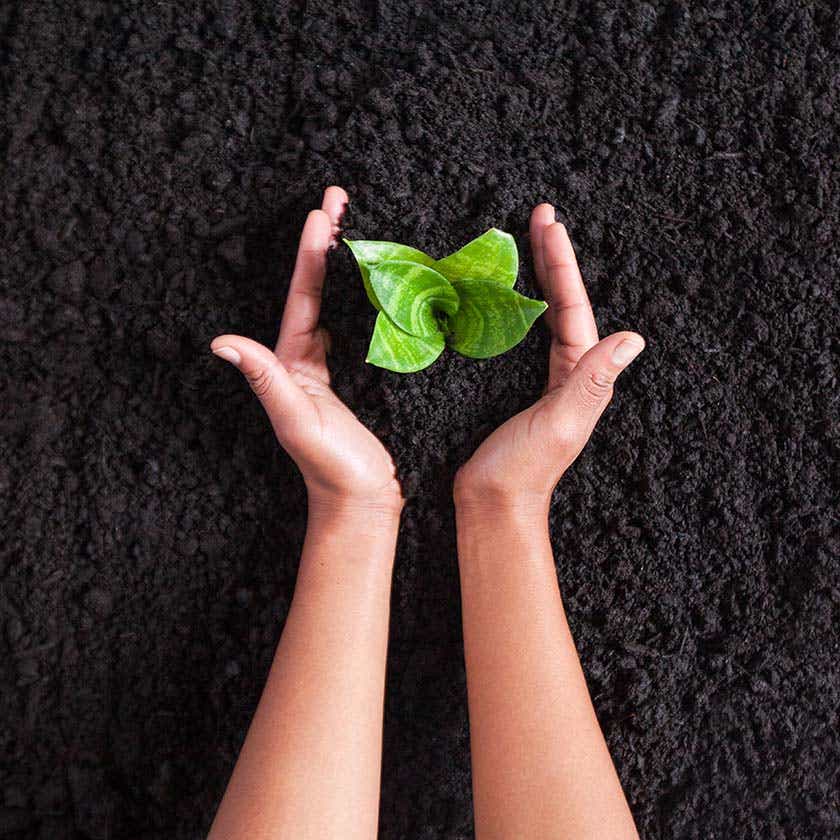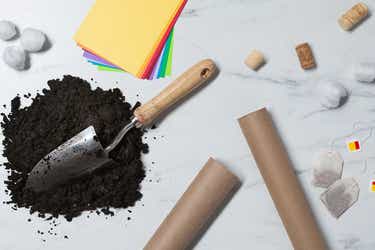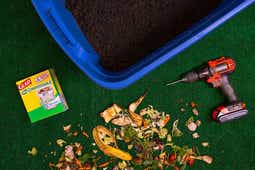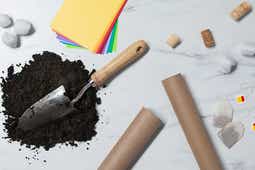Choose the Right Compost Ingredients
Choosing the correct ingredients for your compost bin is crucial for it to function effectively. It’s important to strike the right balance between “green” nitrogen-rich material like old food scraps and yard waste, and “brown” carbon rich material like fallen leaves and old newspaper.
When properly prepared and in the right ratio, these materials create the perfect environment for bacteria and worms to thrive, turning what would be waste into valuable compost. Follow this list of compostable categories to ensure that your compost pile remains healthy and productive.
Composting guidelines vary by locality. Please check with your municipality to confirm acceptable items for composting. Glad® Composting bags are designed for use with municipal composting.

Green
The term “green” here refers to nitrogen-rich materials that provide crucial proteins and amino acids necessary for cell growth within the compost pile. Here is a list of “green” materials that you can include in your compost bin.
- Fruit & vegetable scraps
- Coffee grounds & filters
- Crushed egg shells
- Tea bags made with BPI certified compostable packaging & loose leaf tea
- Cooked rice and pasta
- Stale bread, tortillas and pitas
- Stale potato chips
- Spoiled tomato paste
- Spoiled tofu
- Seaweed
Brown
The term “brown” here refers to materials rich in carbon. These compost materials are important because they work as both the energy source and the basic building block of microbial cells within your compost. Here is a list of “brown” materials that you can include in your compost bin:
- Fallen leaves
- Woody pruning
- Untreated wood sawdust
- Black & white newspaper
- Used paper napkins (not soiled with grease or solvents)
- Used paper towels (not soiled with grease or solvents)
- Unwaxed cardboard (must rip into small pieces)
- Uncoated/unwaxed paper bag (must shred)
- Floor crumbs
- Stale cereal
- Cereal Box (must shred)
- Unwaxed used paper plates
- Nut Shells (except walnut shells)
- Wine corks
- Toothpicks
Special Situations
There are some items that may fall under the aforementioned “green” or “brown” categories but must be given special consideration when being considered for compost. These items may disrupt your pile by inadvertently introducing a nasty fungus, foul odors and unwelcome critters into your backyard. Because every situation is unique, it’s best to leave these items out of your pile unless you are properly prepared for the consequences. Use caution when adding these materials to your compost bin.
*These items can be compostable depending on the compost program. Please contact your local municipality to learn more before composting.
- Jack-o’-Lanterns (smashed)
- Young weeds
- Cooking oil
- Glue
- Latex rubber
- Meats & dairy (recommended to keep isolated or frozen until pickup day to avoid nasty smells)
Turn Your Pile Regularly
Once you make your bin and fill it with the proper ingredients, it’s easy to forget to maintain the mixture. Just like other living organisms, the bacteria in compost needs oxygen to survive, so it’s important to turn the mixture about once a week. Without proper ventilation, the bacteria in the middle of the pile will slow down the process, thus producing less heat. An easy way to tell whether a compost pile needs turning is its internal temperature. Regularly turning your pile provides a series of benefits including:

Ventilation
It’s important to take care of your microorganisms because then they will take care of you. When the microorganisms in your compost pile have the proper amount of oxygen, they are able to break down waste at an increased rate.
Speed
With the amount of compostable waste that we go through in a single day, it can be hard to keep up. When a compost pile is properly ventilated, it breaks down compostable material significantly quicker, allowing for a quicker turnaround between compostable material and usable compost.
Heat Generation
As the microorganisms in your compost begin to work faster, they give off more heat in the process. Heat is essential to the composting process. Without it, intrusive bacteria will thrive and plant seeds won’t get killed off. Although there are many different decomposers hard at work turning plant matter into compost, bacteria is the real powerhouse of a compost pile. When they break down plant matter, they create carbon dioxide and heat which, in turn, creates a more suitable environment for more heat-loving microbes to join the party.
Put Your Finished Compost to Use
One common misconception is that compost has to be collected all in one batch. Most people who compost choose to section off their bin or create multiple bins in order to always have compost at different stages. This means that you would always have some compost just starting off at the same time as compost that is ready for use. This turns composting into a continuous rather than a temporary process.
So now that you’re finished making compost, what do you do with it? The answer is much simpler than you might think. Compost can be used for any sort of garden work that requires soil or fertilizer. Some of the most common uses are:

Soil Amending
Although compost can work as a soil substitute, the best way to maximize its benefits is by mixing it in with the existing soil you already have. Doing so revitalizes the soil, making it much more nutrient rich.
Mulch
Just like the mulch you might buy at a gardening store, mulch made of compost has the ability to suppress weeds and add fertility to your soil. The best part is that you don’t have to treat it any differently than any other type of mulch; spread it around plants and trees. After a few days it will begin to break up and absorb into the soil.
Lawn Dressing
Sprinkling compost on your lawn provides nutrients to the soil, making it healthier and better equipped to hold water. Repeat this process a few times a year and your lawn will appear greener and thicker without the need for additional fertilizers.




